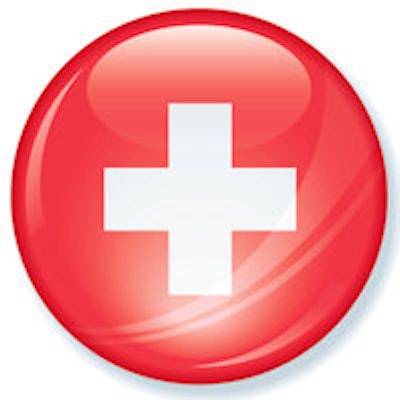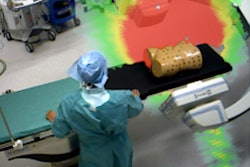
Automatic radiation dose monitoring software is feasible and accurate for monitoring CT doses for trauma patients, Swiss researchers have reported in Clinical Radiology. They also judged it to be quite useful for assessing the impact of dose-reduction initiatives over time.
In an 18-month study, a team from the University of Zurich found the software could accurately extract radiation dose information from all of the nearly 400 patients included in the study. What's more, the institution was able to quantify the impact of implementing dose-reduction techniques such as iterative reconstruction.
"Given the sparse literature on radiation doses in trauma patients, automatic radiation dose-monitoring software helps not only for the awareness of true radiation doses in these patients, but can be also used for tracking changes after implementing dose-lowering techniques," wrote a team led by Dr. Kai Higashigaito of the University of Zurich. "The combination of [iterative reconstruction] and reduced tube current resulted in significantly lower radiation doses without deteriorating the diagnostic yield of the CT studies, both representing techniques that should be applied widely in modern trauma centers."
Monitoring CT dose
CT is often used in trauma patients, but comes with the drawback of radiation dose. A number of techniques such as iterative reconstruction algorithms have been recently implemented to lower patient dose, however. At the same time, healthcare institutions can also now adopt radiation dose-monitoring software for automatically collecting and monitoring radiation dose metrics from imaging studies using ionizing radiation (Clinical Radiology, September 2016, Vol. 71:9, pp. 905-911).
"Such software tools have the advantage of eradicating the need for potentially erroneous and time-consuming manual entryby automatically drawing exposure information directly from the picture archiving and communication system (PACS) or directly from the imaging system," the authors wrote. "Moreover, such automatic software allows for collection of a larger number of patients than by manual typing, resulting in more generalizable results regarding radiation doses."
The research team set out to assess the feasibility and accuracy of automatic radiation dose-monitoring software in trauma patients receiving CT studies with different protocols over time. They also wanted to explore the potential of using iterative reconstruction for achieving radiation dose reduction.
They retrospectively applied DoseWatch radiation dose-monitoring software (GE Healthcare) to a total of 378 chest and CT abdomen exams performed on polytrauma patients from March 2013 to August 2014. After automatically extracting dose metrics -- the CT dose index (CTDIvol) and dose-length product (DLP) -- from the exams, the software then outputted the data to a Microsoft Excel spreadsheet for analysis. Effective dose was calculated by multiplying the DLP with an organ-specific factor. To determine the accuracy of the software, the researchers also manually extracted all radiation dose parameters and the CT protocols for comparison.
The patients were divided into three cohorts based on the CT scanner and protocol used in their study. The first cohort included all polytrauma CT exams between March 2013 and February 2014; all of these studies were performed on a Somatom Definition 64-slice CT scanner (Siemens Healthineers) in a single-source mode. The scanning protocol consisted of 120 kVp tube voltage, 200 mAs reference tube current-time product per rotation using automatic attenuation-based tube current modulation, according to the researchers. These images were reconstructed with a slice thickness of 2 mm, an increment of 1.6 mm, and filtered-back projection.
The second cohort constituted CT studies in polytrauma patients from March 2014 to May 2014. These exams were performed on a Somatom Definition Flash 128-slice dual-source CT scanner (Siemens), again in a single-source mode. While the studies were performed using the same scanning protocol and reconstructed with a slice thickness of 2 mm and an increment of 1.6 mm, these exams received Siemens' sinogram-affirmed iterative reconstruction (SAFIRE) instead of filtered-back projection.
CT exams performed between June 2014 and August 2014 constituted the final cohort for the study. These studies were performed similarly on the same CT scanner used in the second cohort, but with a reduced tube current-time product of 150 mAs per rotation. Images were reconstructed in the same manner as the second cohort.
Patients in all three cohorts received an identical bolus of Ultravist (Bayer Healthcare) nonionic iodinated contrast media. There were no statistically significant differences between the cohorts for injury severity score, new injury severity score, and trauma mechanism, according to the group.
An accurate tool
The researchers found the software accurately captured dose metrics in every patient.
"Compared to manual dose tracking, which is time-consuming and may be prone to typographical errors, automatic radiation dose-monitoring tools overcome these limitations, allowing analysis of larger numbers of examinations relatively quickly," the authors wrote. "It is important to note that radiation dose information gathered by the software was fully accurate, which is mandatory before such tools are used in a clinical setting."
The software also was able to quantify the effects of dose-reduction efforts over time.
| Average radiation dose metrics by patient cohort | |||
| Cohort 1 (CT scans with filtered-back projection) |
Cohort 2 (CT scans with iterative reconstruction) |
Cohort 3 (CT scans with reduced tube current and iterative reconstruction) |
|
| CTDIvol (mGy) | 19.7 ± 5.8 | 20.5 ± 7 | 14.8 ± 3 |
| DLP (mGy/cm) | 1456 ± 412 | 1481 ± 522 | 1090 ± 246 |
| Effective dose (mSv) | 21.1 ± 6 | 21.5 ± 7.6 | 8.8 ± 3.6 |
While the difference in CTDIvol between cohort 1and 2 did not reach statistical significance, the differences between cohort 1 and 3 (p < 0.017) and between 2 and 3 (p < 0.017) were statistically significant. A similar trend was found in comparing DLP and effective dose; the differences between cohort 1 and 3 (p < 0.017) and cohort 2 and 3 (p < 0.017) were statistically significant.
In other findings, the researchers noted that independent review of the CT exams by two radiologists found all studies to be fully diagnostic.
"The ... study shows how automatic radiation dose-monitoring software can be used in a clinical setting for collecting and analyzing radiation dose metrics of a large cohort of trauma patients over time, eventually allowing for comparisons between various CT systems and protocols," the authors concluded.



















